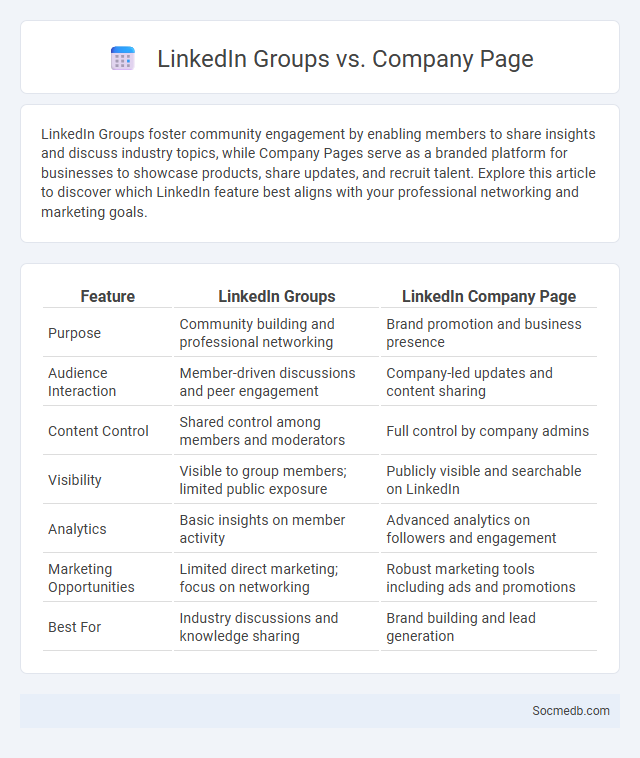
Photo illustration: LinkedIn Groups vs Company Page
LinkedIn Groups foster community engagement by enabling members to share insights and discuss industry topics, while Company Pages serve as a branded platform for businesses to showcase products, share updates, and recruit talent. Explore this article to discover which LinkedIn feature best aligns with your professional networking and marketing goals.
Table of Comparison
| Feature | LinkedIn Groups | LinkedIn Company Page |
|---|---|---|
| Purpose | Community building and professional networking | Brand promotion and business presence |
| Audience Interaction | Member-driven discussions and peer engagement | Company-led updates and content sharing |
| Content Control | Shared control among members and moderators | Full control by company admins |
| Visibility | Visible to group members; limited public exposure | Publicly visible and searchable on LinkedIn |
| Analytics | Basic insights on member activity | Advanced analytics on followers and engagement |
| Marketing Opportunities | Limited direct marketing; focus on networking | Robust marketing tools including ads and promotions |
| Best For | Industry discussions and knowledge sharing | Brand building and lead generation |
Understanding LinkedIn Groups, Company Pages, and Employer Branding
LinkedIn Groups foster professional networking and niche industry discussions, enabling you to connect with like-minded peers and exchange valuable insights. Company Pages serve as dynamic hubs to showcase your brand identity, share updates, and attract potential clients or employees through targeted content. Employer Branding leverages your company's online presence to highlight culture and values, enhancing recruitment efforts and building trust with your audience.
Key Features of LinkedIn Groups
LinkedIn Groups offer professionals a platform to network, share insights, and discuss industry trends within a targeted community. Key features include the ability to create and join groups based on specific professions or interests, participate in focused discussions through posts and comments, and access exclusive content shared by group members. Enhanced group management tools allow moderators to curate content, enforce group rules, and facilitate event organization, fostering meaningful connections and knowledge exchange.
Benefits of Using LinkedIn Company Pages
LinkedIn Company Pages boost your brand visibility by showcasing your business, products, and services to a professional audience. You gain access to detailed analytics that help track engagement and optimize your marketing strategies. Your company can nurture relationships with potential clients, partners, and talent, driving growth and industry credibility.
The Role of Employer Branding on LinkedIn
Employer branding on LinkedIn significantly influences talent acquisition by showcasing company culture, values, and employee experiences to a professional audience. Leveraging optimized LinkedIn profiles, employee testimonials, and targeted content increases visibility and attracts top-tier candidates aligned with organizational goals. Companies with strong LinkedIn employer brands report higher engagement rates, reduced hiring costs, and improved retention rates due to enhanced trust and reputation.
Audience Engagement: Groups vs Company Pages
Audience engagement on social media varies significantly between Groups and Company Pages, with Groups fostering more interactive and community-driven discussions due to their member-centric features. Company Pages often serve as broadcast channels emphasizing brand messaging and content distribution, resulting in higher follower counts but typically lower direct engagement rates. Marketing strategies leveraging Groups can benefit from authentic conversations and user-generated content, enhancing brand loyalty and trust.
Content Strategies for Groups, Pages, and Employer Branding
Effective content strategies for social media groups and pages involve creating tailored, engaging posts that foster community interaction and brand loyalty. By leveraging employer branding, businesses can showcase company culture, employee stories, and core values to attract top talent and enhance overall reputation. Consistent, authentic content combined with data-driven insights maximizes reach, engagement, and conversion across platforms like Facebook, LinkedIn, and Instagram.
Lead Generation: Which Approach Delivers Better Results?
Social media lead generation strategies perform best when tailored to target audience behavior and platform-specific features, with paid ads often delivering higher conversion rates due to precise targeting and analytics. Organic content marketing fosters long-term engagement and trust, leading to quality leads through consistent value and community building. Combining both approaches, utilizing data-driven insights from platforms like LinkedIn, Facebook, and Instagram, maximizes lead volume and lead quality effectively.
Measuring Success: Analytics and Performance Metrics
Social media success is measured through key analytics and performance metrics such as engagement rate, reach, impressions, and conversion rates. Tools like Google Analytics, Facebook Insights, and Instagram Analytics provide detailed data on user interactions, audience demographics, and content effectiveness. Tracking metrics like click-through rates (CTR) and follower growth enables businesses to optimize strategies and maximize return on investment (ROI).
Challenges and Limitations of Each Approach
Social media platforms face significant challenges such as privacy concerns, misinformation spread, and algorithmic bias impacting user experience and content visibility. Limited content moderation resources often result in inconsistent enforcement of community standards, while varying platform policies create fragmented regulatory environments. User engagement metrics can incentivize sensationalism, reducing content quality and fostering echo chambers that limit diverse viewpoints.
Best Practices for Integrating Groups, Pages, and Employer Branding
Maximize your social media impact by strategically integrating Groups, Pages, and employer branding to foster authentic community engagement and enhance brand visibility. Establish consistent messaging across Pages for official updates, while leveraging Groups for interactive discussions and personalized connections that humanize your company. Use employer branding within these platforms to showcase your corporate culture, attract talent, and build loyalty among employees and followers alike.
 socmedb.com
socmedb.com